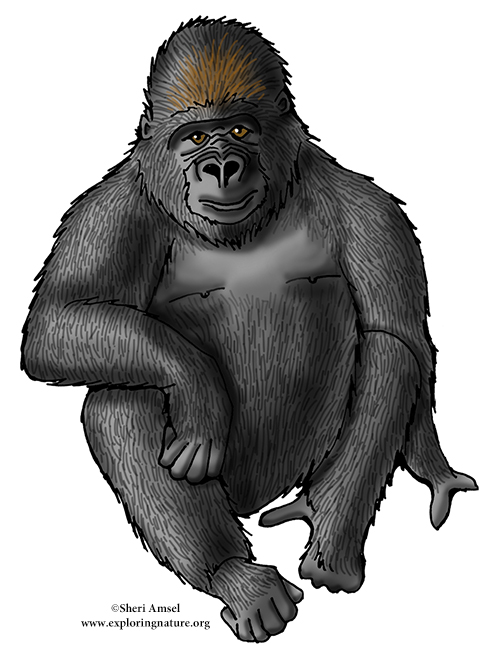

Gorillas live in Central Africa. The mountain gorillas of Rwanda, Zaire and Uganda have become very rare. There are two groups of lowland gorillas: the eastern lowland gorillas of Zaire and the western lowland gorillas of Cameroon, Congo, Gabon, Central African Republic, and Guinea.
Gorillas live in rainforests.
An adult male gorilla can reach 6 feet in height and weigh up to 500 pounds. Females rarely get bigger than 300 pounds. Most gorillas have dark fur, but some male gorillas have silver-tipped hairs on their shoulders and back, so are called silverbacks.
They live in family groups of many females, young males and one large, mature male. Gorillas, in general, are not aggressive unless threatened.
Gorillas are vegetarians, eating the leaves, stems and roots of plants.
Predators are leopards, crocodiles and humans.
Females are pregnant for 9 months (gestation) and have 1 young.
They live about 30 years in the wild. They are critically endangered.
Kingdom: Animalia
Phylum: Chordata
Subphylum: Vertebrata
Class: Mammalia
Order: Primates
Suborder: Haplorrhini
Family: Hominidae
Genus: Gorilla
Species: Gorilla gorilla
When you research information you must cite the reference. Citing for websites is different from citing from books, magazines and periodicals. The style of citing shown here is from the MLA Style Citations (Modern Language Association).
When citing a WEBSITE the general format is as follows.
Author Last Name, First Name(s). "Title: Subtitle of Part of Web Page, if appropriate." Title: Subtitle: Section of Page if appropriate. Sponsoring/Publishing Agency, If Given. Additional significant descriptive information. Date of Electronic Publication or other Date, such as Last Updated. Day Month Year of access < URL >.
Amsel, Sheri. "Gorilla" Exploring Nature Educational Resource ©2005-2024. December 13, 2024
< http://www.exploringnature.org/db/view/Gorilla >


